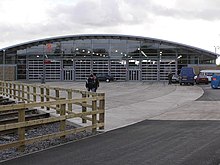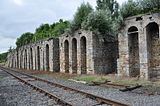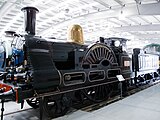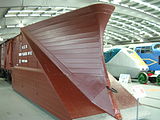National Railway Museum Shildon Contents Overview Site Museum landmarks Locomotives See...
Heritage railways in County DurhamMuseums established in 2004Museums in County DurhamMuseums sponsored by the Department for Digital, Culture, Media and SportRailway museums in England2004 establishments in EnglandScience Museum Group
railwaymuseumShildonCounty DurhamScience Museum GroupPrime MinisterTony BlairDurham County CouncilGulbenkian PrizeSoho WorksStockton and Darlington RailwayDarlingtonShildon wagon worksShildon stationTees Valley LineNorthernTimothy Hackworthcoal dropslocomotivesRainhill TrialsLiverpoolManchesterLNER Class A4 4468 MallardA460008 "Dwight D Eisenhower"60010 "Dominion of Canada"APT-EDelticwind turbineNational GridbiodieselenvironmentNER No.1, electric, 1903LMS Hughes CrabSans Pareil, 1829LNWR CornwallLSWR T3 classSnow plough
 The exterior of the main exhibition hall | |
| Established | September 2004 (2004-September) |
|---|---|
| Location | Shildon |
| Coordinates | 54°37′27″N 1°37′50″W / 54.6243°N 1.6306°W / 54.6243; -1.6306 |
| Type | Railway museum Transport museum Collection Museum Children's museum Open-air museum |
| Visitors | 185,000 (2017)[1] |
| Director | Judith McNicol |
| Public transit access | Shildon railway station |
| Website | Museum Website |
Locomotion, also known as Locomotion: the National Railway Museum at Shildon or Shildon Locomotion Museum is a railway museum in Shildon, County Durham, England. The museum is part of the Science Museum Group.[2]
Contents
1 Overview
2 Site
3 Museum landmarks
4 Locomotives
5 See also
6 Notes
7 References
8 External links
Overview
The museum was opened on 22 October 2004 by Prime Minister Tony Blair.[3] Built at a cost of £11.3 million, it is based on the former "Timothy Hackworth Victorian Railway Museum". The museum is operated in partnership with Durham County Council and was expected to bring 60,000 visitors a year to the small town. However, during its first six months, the museum attracted 94,000 visits. In the 12 months to March 2013, the museum had 230,000 visitors.[4] Locomotion was shortlisted as one of the final five contenders in the Gulbenkian Prize, which is the largest arts prize in the United Kingdom.
Site
The museum is sited near Timothy Hackworth's Soho Works on the world's first passenger railway, the Stockton and Darlington Railway (opened on 27 September 1825 with a train hauled by Locomotion No 1 which took 2 hours to complete the 12-mile journey from Shildon to Darlington). The town was to become a major centre for British railway engineering thanks to the Shildon wagon works, which closed in 1984.[5]
Shildon station, on the Tees Valley Line was rebuilt and modernised as part of the museum's construction and is actually situated adjacent to the trail and demonstration rail line through the museum site. It is served by all services on the line, operated by Northern.
Museum landmarks
The museum is arranged as stops along the 1 km demonstration line with station direction board signs and information points on the trail between the car parks and the main collection building. The museum has a six-spur apron in front of the main shed and another short length of track for showing off resident locomotives and visiting trains.
The trail starts at the 19th-century welcome building. The original Sans Pareil is on display here.
The second building is Timothy Hackworth's house.[6] It contains several activities about the history of Shildon. Soho is a stone building that was a railway workshop, having originally been an iron merchant’s store. The fourth stop is the former goods shed for the town, with most incoming and outgoing goods being delivered to the railway by horse and cart. The building is built partially from recycled stone sleeper blocks, the old fixing slots being visible in the wall.[7]
The railway station's parcel office is the next part of the trail and at the junction, visible across the tracks are the former stables for the early horse-drawn wagonways that linked to the line. The coal drops were a refuelling point for steam locomotives. Wagons were hauled up an incline and the coal 'dropped' down wooden chutes into the tender below.[8][9] The light engine is an interactive pole that displays colours. You can change the name of the pole if you text in.
The trail passes under the roadway. There is a children's playground and a picnic area outside the Collection building. The trail ends at the largest building in the museum. It contains the exhibition hall and a conservation workshop with viewing gallery to see the work carried out by volunteers restoring some of the exhibits. Other facilities in the building include interactive games, a cafe and shop.
.mw-parser-output .mod-gallery{display:table}.mw-parser-output .mod-gallery-default{background:transparent;margin-top:0.5em}.mw-parser-output .mod-gallery-center{margin-left:auto;margin-right:auto}.mw-parser-output .mod-gallery-left{float:left}.mw-parser-output .mod-gallery-right{float:right}.mw-parser-output .mod-gallery-none{float:none}.mw-parser-output .mod-gallery-collapsible{width:100%}.mw-parser-output .mod-gallery .title{display:table-row}.mw-parser-output .mod-gallery .title>div{display:table-cell;text-align:center;font-weight:bold}.mw-parser-output .mod-gallery .main{display:table-row}.mw-parser-output .mod-gallery .main>div{display:table-cell}.mw-parser-output .mod-gallery .caption{display:table-row;vertical-align:top}.mw-parser-output .mod-gallery .caption>div{display:table-cell;display:block;font-size:94%;padding:0}.mw-parser-output .mod-gallery .footer{display:table-row}.mw-parser-output .mod-gallery .footer>div{display:table-cell;text-align:right;font-size:80%;line-height:1em}.mw-parser-output .mod-gallery .gallerybox .thumb img{background:none}.mw-parser-output .mod-gallery .bordered-images img{border:solid #eee 1px}.mw-parser-output .mod-gallery .whitebg img{background:#fff!important}.mw-parser-output .mod-gallery .gallerybox div{background:#fff!important}

Hackworth's cottage

Soho workshop

Goods shed

Coal drops

Engine Shed interior
Locomotives
The museum is home to several locomotives from the National Collection, including a replica of Timothy Hackworth's Sans Pareil. The original engine, built to compete in the Rainhill Trials, is also at Shildon. The trials were to decide which engine should operate the passenger railway between Liverpool and Manchester. After a 175 years absence from the town, the locomotive was returned and is displayed in the Welcome building.[10]LNER Class A4 4468 Mallard which is usually displayed in the NRM's York museum was temporarily displayed in the museum from June 2010 to July 2011.[11] In 2014, ahead of the 75th anniversary celebrations for Mallard’s setting the world steam speed record, 8,000 visitors turned up to welcome five sister A4 locomotives including 60008 "Dwight D Eisenhower" and 60010 "Dominion of Canada" that were repatriated from North America, the latter was given a cosmetic overhaul in Shildon's workshop.
The main exhibition building houses most of the collection and includes the sole examples of the prototype APT-E and Deltic units.[12] The museum has a wind turbine which provides power to the National Grid and an on-site biodiesel bus for transporting visitors around the site without harming the environment.

NER No.1, electric, 1903

LMS Hughes Crab

Sans Pareil, 1829

LNWR Cornwall

LSWR T3 class No. 563

Snow plough (1891)
See also
- List of British railway museums
- List of transport museums
B&O Railroad Museum (US)
Exporail (Canada)
Nuremberg Transport Museum (Germany)
Workshops Rail Museum (Australia)
Notes
^ "ALVA - Association of Leading Visitor Attractions". www.alva.org.uk. Archived from the original on 13 April 2015. Retrieved 4 May 2018..mw-parser-output cite.citation{font-style:inherit}.mw-parser-output .citation q{quotes:"""""""'""'"}.mw-parser-output .citation .cs1-lock-free a{background:url("//upload.wikimedia.org/wikipedia/commons/thumb/6/65/Lock-green.svg/9px-Lock-green.svg.png")no-repeat;background-position:right .1em center}.mw-parser-output .citation .cs1-lock-limited a,.mw-parser-output .citation .cs1-lock-registration a{background:url("//upload.wikimedia.org/wikipedia/commons/thumb/d/d6/Lock-gray-alt-2.svg/9px-Lock-gray-alt-2.svg.png")no-repeat;background-position:right .1em center}.mw-parser-output .citation .cs1-lock-subscription a{background:url("//upload.wikimedia.org/wikipedia/commons/thumb/a/aa/Lock-red-alt-2.svg/9px-Lock-red-alt-2.svg.png")no-repeat;background-position:right .1em center}.mw-parser-output .cs1-subscription,.mw-parser-output .cs1-registration{color:#555}.mw-parser-output .cs1-subscription span,.mw-parser-output .cs1-registration span{border-bottom:1px dotted;cursor:help}.mw-parser-output .cs1-ws-icon a{background:url("//upload.wikimedia.org/wikipedia/commons/thumb/4/4c/Wikisource-logo.svg/12px-Wikisource-logo.svg.png")no-repeat;background-position:right .1em center}.mw-parser-output code.cs1-code{color:inherit;background:inherit;border:inherit;padding:inherit}.mw-parser-output .cs1-hidden-error{display:none;font-size:100%}.mw-parser-output .cs1-visible-error{font-size:100%}.mw-parser-output .cs1-maint{display:none;color:#33aa33;margin-left:0.3em}.mw-parser-output .cs1-subscription,.mw-parser-output .cs1-registration,.mw-parser-output .cs1-format{font-size:95%}.mw-parser-output .cs1-kern-left,.mw-parser-output .cs1-kern-wl-left{padding-left:0.2em}.mw-parser-output .cs1-kern-right,.mw-parser-output .cs1-kern-wl-right{padding-right:0.2em}
^ "Science Museum Group". Science Museum Group. Archived from the original on 13 December 2018. Retrieved 30 August 2013.
^ "Prime Minister opens Shildon Locomotion museum" The Railway Magazine issue 1244 December 2004 page 5
^ Opening Minds Securing Our Futures Annual Review 2012-13, Science Museum Group, London, 2013 p75.
^ Coulls 2012, p. 3
^ Coulls 2012, p. 27
^ Coulls 2012, p. 38
^ Coulls 2012, p. 5
^ Coulls 2012, p. 23
^ Coulls 2012, p. 5
^ Coulls 2012, p. 18
^ Coulls 2012, p. 52
References
- Coulls, Anthony (1 February 2012), Spirit of Locomotion: The National Railway Museum at Shildon, Series: Spirit of Britain, Halsgrove,
ISBN 978-0-85710-064-1.
External links
| Wikimedia Commons has media related to Shildon Locomotion Museum. |
- Museum website
The official National Railway Museum print website containing many vintage posters and prints from the museum's collections
Coordinates: 54°37′27″N 1°37′50″W / 54.6243°N 1.6306°W / 54.6243; -1.6306











